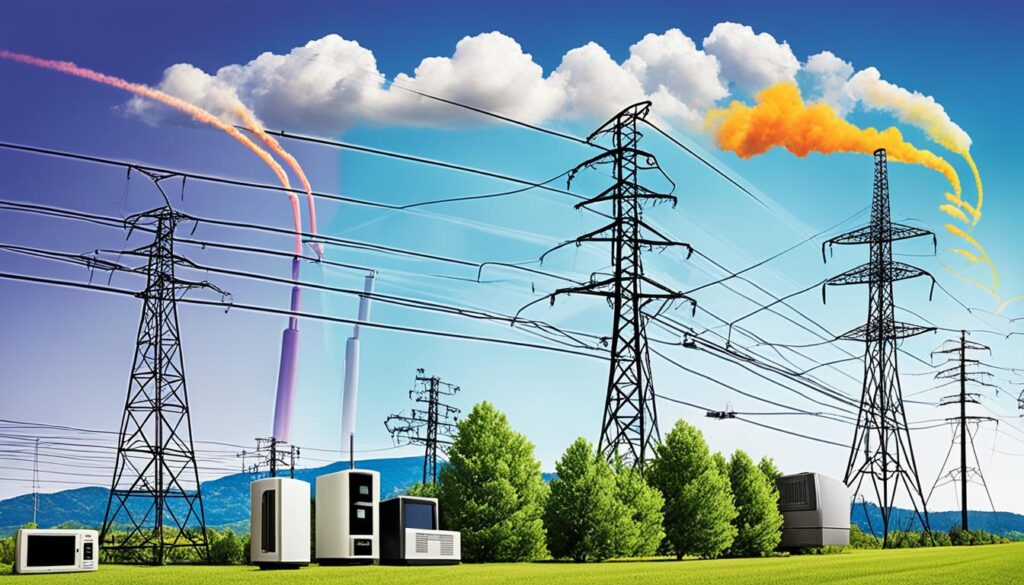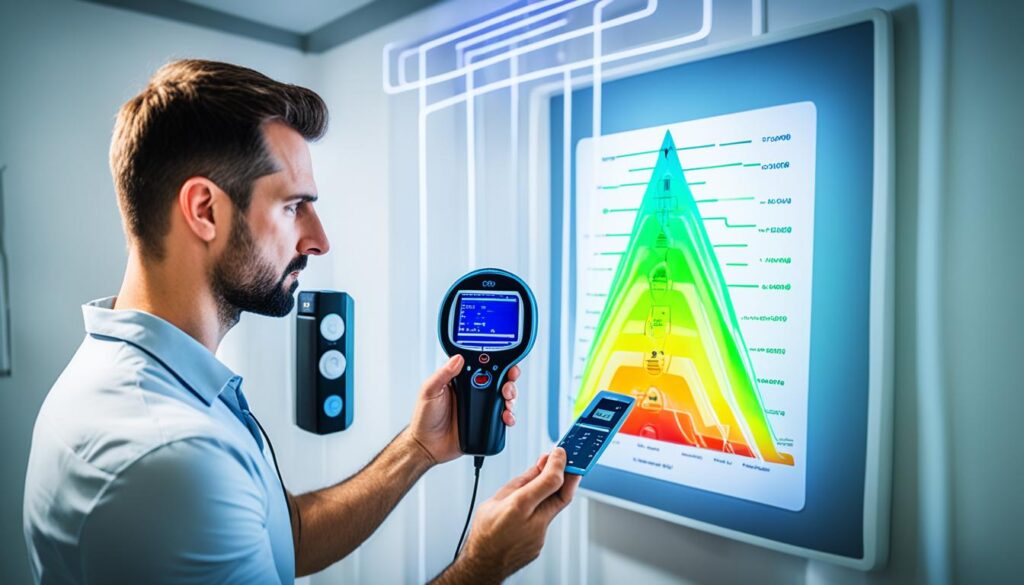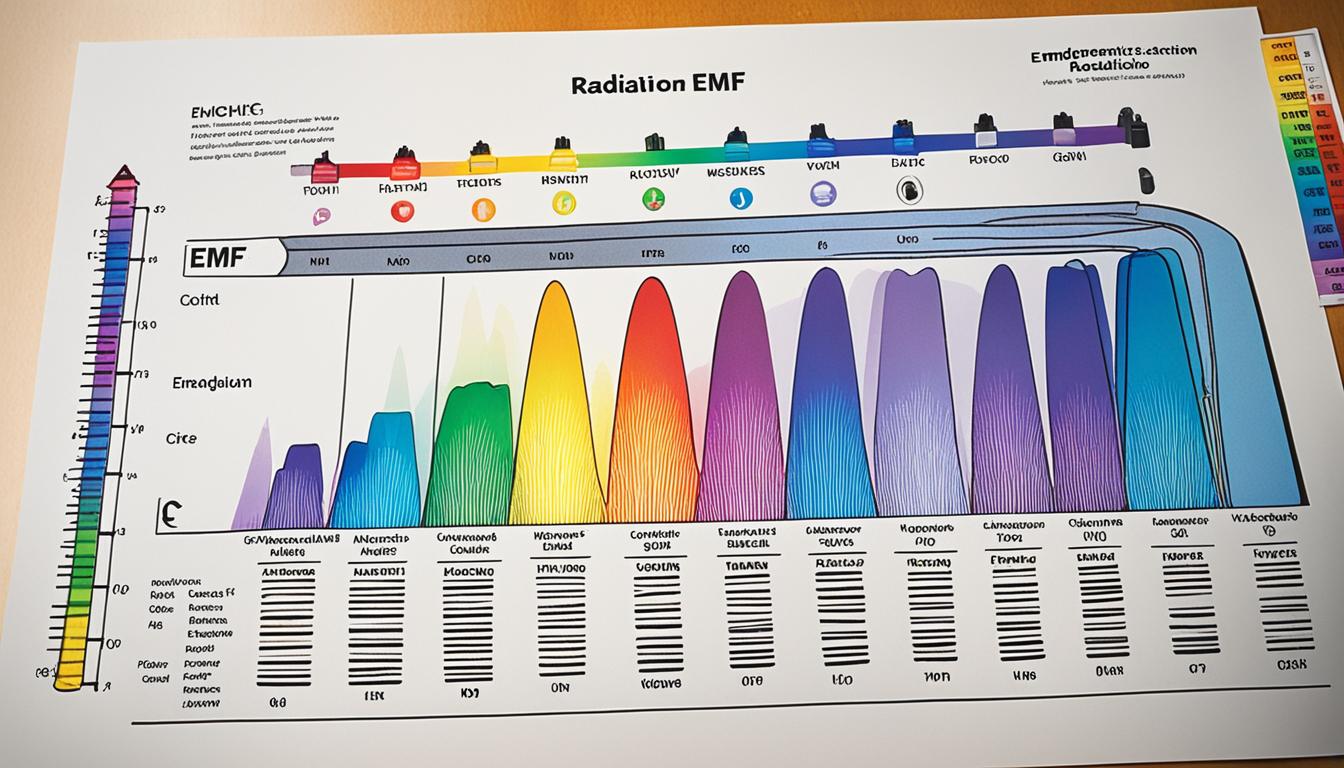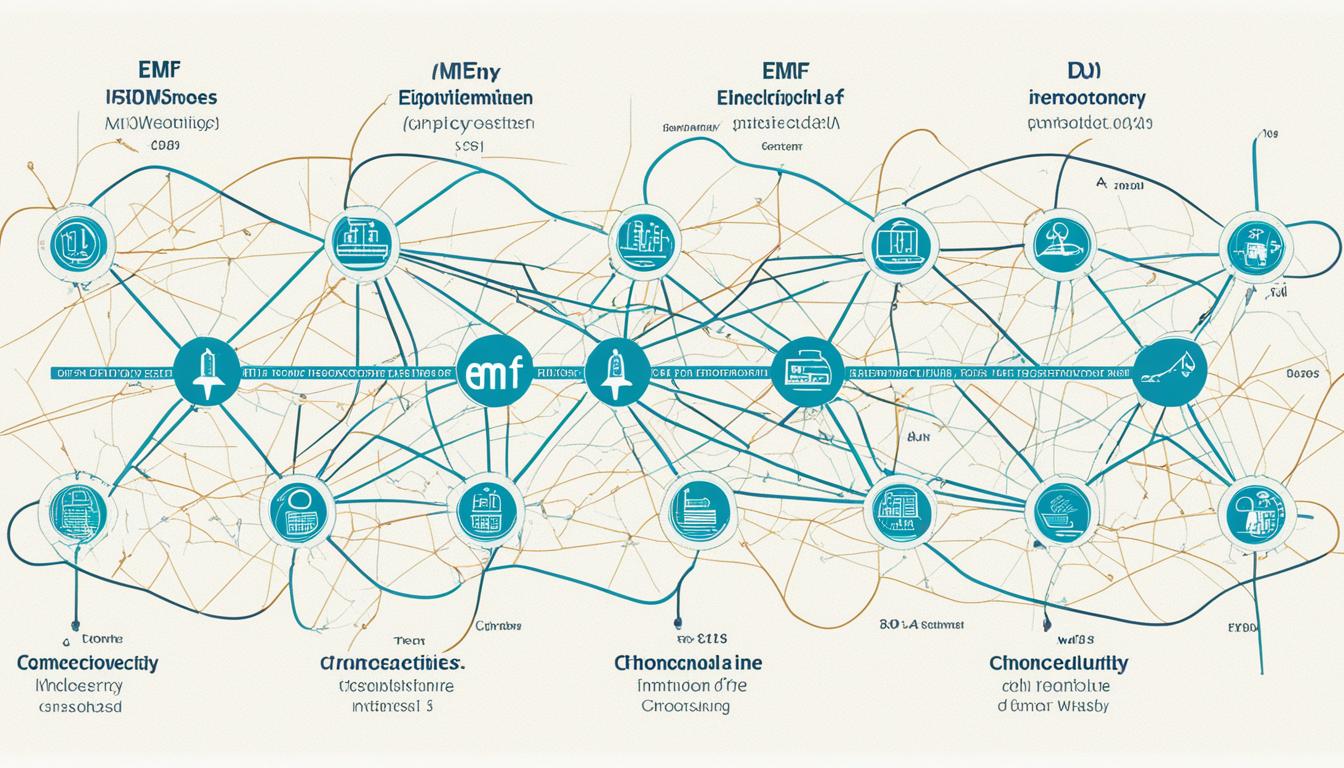Disclosure: This Post Contains Affiliate Links; We earn a commission on purchases.
Electromagnetic Fields, commonly known as EMFs, are an intrinsic part of the world we inhabit. Invisible yet essential, these fields blanket our surroundings, emerging from the integration of electricity within society and nature’s own handiwork. EMF basics tell us that these fields are comprised of electric and magnetic energies, undetectable to the naked eye yet ever-present across the spectrum of our daily lives. From the EMF radiation produced by our gadgets to the waves that enable light to permeate space, understanding EMFs is a key aspect of grasping the essence of Electromagnetic Frequency.
Despite their invisibility, EMFs actively forge our reality, interlacing through our homes, workplaces, and natural environments. As we deepen our understanding of these fields, we begin to realize the importance of acknowledging their presence, exploring their nature, and considering their influence on health and technology. Let’s embark on a journey to unravel the mysteries behind these unseen forces, equip ourselves with knowledge, and harness the power of EMFs for a well-informed, technology-savvy populace.
Key Takeaways
- EMFs are ubiquitous energy areas stemming from electrical usage and natural phenomena.
- Understanding EMF basics is essential for navigating our tech-centric world.
- Non-ionizing and ionizing are the two main types of EMF radiation, with differing health implications.
- Electromagnetic Frequency encompasses various spectrums of energy, both seen and unseen.
- Comprehending the nature of EMFs allows us to make informed decisions about technology and health.
What is Electromagnetic Field (EMF) and Its Importance
The world around us is governed by forces unseen, chief among them electromagnetic fields (EMFs). Whether stemming from the natural occurrences within the Earth’s mantle or engineered by human ingenuity, EMFs play a pivotal role in our everyday lives. Digging into the EMF science reveals the complexity and vitality of these invisible fields in the world of technology, nature, and health.
The Basic Science Behind EMF
At the core of EMF is the movement of electrons, sparking phenomena we term as the electric field and the magnetic field. The electric field springs to life via voltage—the driving force propelling electrons through conductors. Measuring the strength of this field happens in volts per meter (V/m). Conversely, the magnetic component is all about the flow of current, quantified in microteslas (μT). While objects can shield electric fields, magnetic fields display their tenacity by flowing through most barriers, dwindling only with distance.
Key Distinctions: Ionizing vs Non-Ionizing EMFs
Enter the realm of EMFs and one encounters two distinct kinds—ionizing radiation and non-ionizing radiation. Non-ionizing EMFs, which include daily EMF sources like power lines and Wi-Fi, pal around at the lower end of the frequency scale, and are generally seen as benign to human tissue and DNA. On the flip side, ionizing EMFs, characterized by sources such as X-rays and ultraviolet light, carry enough gusto to knock electrons off their atomic orbits, potentially causing DNA damage and leading to health concerns.
EMF in Our Daily Lives
In an average day, we are immersed in a sea of EMFs: from the natural EMFs like the Earth’s magnetic field guiding compass needles, to the man-made EMFs emitted by a cornucopia of devices. Our homes, offices, and recreational spaces teem with EMF radiation from electrical appliances, cell phones, and various forms of wireless communication. Understanding the nuances of EMF exposure can lend insight into managing our interaction with these fields and mitigates concerns about EMF health effects.
| Type of EMF | Frequency Range | Common Sources | Potential Health Effects |
|---|---|---|---|
| Non-Ionizing EMFs | Low to Mid-Frequency | Power lines, Household Appliances, Wi-Fi | Generally considered harmless |
| Ionizing EMFs | High-Frequency | Ultraviolet Light, X-Rays, Gamma Rays | Can cause cellular and DNA disruption |
From shielding our devices to mitigating EMF health effects, being circumspect about these omnipresent energies can empower us to live harmoniously amidst the dance of electrons and fields. As we go about our days, it behooves us to remember: it’s an EMF world—we’re just living in it.
The Various Sources and Examples of EMF
Electromagnetic fields (EMFs) are the unseen but essential elements fundamentally weaving into the tapestry of our environment. The dual nature of natural EMF sources like the earth magnetic field and man-made EMF sources such as power lines creates a spectrum of EMFs that affect our daily lives. Understanding where these EMFs originate helps in forming a comprehensive view of the electromagnetic landscape we live in.

Natural and Man-Made EMF Sources
Our planet itself is a generator of EMFs, with the earth magnetic field being a prime example of natural EMF sources. This geomagnetic field is a fundamental navigational tool for migratory species and affects everything from auroras to climate patterns. Contrastingly, human progress has given rise to an array of man-made EMF sources, including the low-frequency EMFs emitted from power lines, electrical appliances, and radiofrequency radiation from wireless technology. Both sources coexist, creating the complex EMF environment that encapsulates the modern world.
A Look at Low to Mid-Frequency Non-Ionizing Radiation
In the EMF spectrum, non-ionizing EMFs occupy the lower frequencies, including low-frequency EMFs and ELF-EMFs across our homes and workplaces. These are fields emitted by electrical systems and devices, ranging from kitchen appliances to the base stations of wireless networks. It’s crucial to note that non-ionizing EMFs, while pervasive, aren’t known to directly damage DNA or cellular structures. Therefore, they’re often considered safe, with common examples being Wi-Fi routers and bluetooth devices.
Ionizing Radiation: High-Frequency EMFs
At the higher end of the EMF spectrum, we encounter ionizing radiation, comprising high-frequency EMFs like UV rays from sunlight and X-rays used in medical diagnostics. Unlike non-ionizing radiation, ionizing radiation holds enough energy to interfere with molecular bonds and ionize atoms, hence its capability to alter cell structure and potentially cause DNA damage. Awareness and protection are key when dealing with these forms of EMF, as prolonged or intense exposure can be harmful to biological tissues.
| EMF Type | Nature | Common Sources | Health Impact Consideration |
|---|---|---|---|
| Non-Ionizing Low to Mid-Frequency EMFs | Natural and Man-Made | Earth’s Magnetic Field, Household Appliances, Wi-Fi, Power Lines | Generally regarded as safe |
| Ionizing High-Frequency EMFs | Natural and Secondary Man-Made | Sunlight (UV Rays), Medical X-Rays, Gamma Rays | Potential to cause cellular and DNA damage |
Electromagnetic Field (EMF)
In our modern environment, the existence of Electromagnetic Fields (EMFs) is as common as the air we breathe. These potent but unseen forces play a significant role in our everyday lives, from the home appliances we rely upon to the sophisticated gadgets that keep us connected. The increasing need for EMF detection and awareness points to a broader concern about environmental health and safety.

The discussion around EMFs has intensified with the condition known as electromagnetic hypersensitivity (EHS). This purported condition, while not scientifically recognized as a medical diagnosis, has sparked debates and research on the potential health implications of constant EMF exposure. Consequently, a rising demand for EMF safety tips and informed practices to manage EMF interaction has emerged.
While EMFs permeate almost all aspects of industrialized life, understanding their nuances is vital. Here are some pointers to help individuals navigate the realms of EMFs:
- Acquiring EMF detectors can aid in mapping out hotspots within living and working environments.
- Leveraging built-in features on devices that minimize EMF emission.
- Practicing mindful use of technology to limit unnecessary exposure.
- Designing living spaces that take into account the distance from EMF sources, adhering to the inverse-square law of electromagnetic propagation.
The collective effort to discern and disseminate practical advice on EMFs not only enhances our grasp of these forces but also equips us to create healthier and more conscientious spaces in which technology and well-being coexist harmoniously.
The Intertwinement of EMF and Modern Technology
In the tapestry of today’s world, the threads of electromagnetic fields (EMFs) are intricately woven with the fabric of modern technology. As we delve into the essence of contemporary tech, it becomes clear that EMFs are not just a by-product but a foundational element in the era of wireless communication and rapid technological expansion.
The Era of Wireless Communication and EMF Exposure
The surge of wireless communication has made mobile technology like smartphones, laptops, and the ever-expanding Internet of Things indispensable. These devices utilize radio frequency radiation, a type of EMF exposure that has been the subject of extensive research by institutions such as the National Toxicology Program. This research aims to address public concerns surrounding the long-term effects of EMF, especially with respect to potential health risks, including those related to cancer.
EMF and Household Appliances
All around us, everyday EMF household appliances and electrical devices emit EMFs when they are turned on and current is flowing. Whether we are cooking a meal in a microwave or chilling our food in refrigerators, we are in the vicinity of EMFs. Proximity to these sources is critical, as the magnetic field strength decreases significantly with increasing distance from the origin of the EMF, affecting the level of human exposure in residential spaces.
EMF in Medical Applications
Meanwhile, the medical domain has embraced the positive aspects of EMF application. In diagnostic procedures and treatments, devices like MRI machines leverage the power of non-ionizing EMFs—the safer segment of the EMF spectrum—to create medical imaging of unparalleled detail. EMF medical applications represent the harmony between human health and electromagnetic technology, offering a perspective on how controlled EMF exposure can be substantially beneficial.
Understanding this coexistence and the practicalities of EMF within technology helps us navigate our modern landscape responsibly, using technology to enhance our lives while appreciating the underlying complexities of EMF interaction. From advanced medical diagnostics to our myriad of wireless devices, EMF is a significant, though invisible, force in innovation and daily convenience.
Probing into the Health Effects of EMF
The conversation about EMF health effects is longstanding and complex, as ongoing EMF research aims to clarify the impact of electromagnetic fields on human well-being. While a definitive causal link between EMF exposure and health outcomes such as childhood Leukemia and adult cancers remains elusive, the quest for answers persists.
Historically, the 1990s were pivotal in directing scientific focus on the potential health implications of EMFs, especially those emanating from power lines and home appliances. Early studies suggested a potential, though weak association, between EMF exposure and an increased risk of childhood Leukemia. Despite this indication, the correlation was not robust, and subsequent EMF research on adult populations has generally failed to demonstrate a clear link with various forms of cancer, including Leukemia and brain cancer.
The National Institute of Environmental Health Sciences (NIEHS) promotes continued inquiry into this critical area. Understanding that our environment is replete with sources of non-ionizing and ionizing radiation, from cell phones to MRIs, the importance of discerning their effects can’t be overstressed. As new technologies proliferate, developing a deeper understanding of EMF and health remains paramount.
- Early studies indicated a potential link between EMF exposure and childhood Leukemia.
- Numerous EMF research endeavors have yet to find conclusive evidence connecting EMF exposure to adult cancers.
- The NIEHS suggests that EMF literacy and practical exposure reduction strategies are essential for public health.
As we continue to surround ourselves with devices and systems that generate EMFs, equipping ourselves with accurate information has never been more vital. Investigations spearheaded by reputable organizations like the NIEHS provide the groundwork for understanding how best to integrate evolving technologies into our lives while safeguarding our health.
EMF Protection and Safety Measures
In the era of ubiquitous technology, the subject of EMF protection has become increasingly pertinent. As we weave through the landscape of modern life, drenched in an array of EMFs from various devices, it’s crucial to consider EMF safety and how best to reduce unwanted electromagnetic exposure. Adherence to protocols for exposure reduction and the utilization of various EMF shielding methods play a vital role in ensuring our well-being in this invisible milieu.
Best Practices for EMF Exposure Reduction
In the interest of EMF safety, adopting practical ways to reduce EMF exposure can be as straightforward as adjusting our daily habits. The National Institute of Environmental Health Sciences (NIEHS) encourages public education on how to minimize EMF interaction as an essential aspect of self-care. Mindful practices such as turning off devices when not in use, adhering to manufacturer-specified distances for appliance usage, and favoring wired connections over wireless where possible are a few exposure reduction strategies recommended by health experts.
EMF Shielding Techniques and Materials
When it comes to EMF shielding, several materials and shielding techniques are designed to diminish EMF permeation. These include fabrics interwoven with silver, copper, or aluminum. The efficiency of EMF protective materials depends on their conductive or magnetic properties, which act to counteract the EMF’s influence. Practical applications range from EMF-blocking phone cases to lining walls with materials that can reduce EMF penetration from outside sources.
Deciphering EMF Safety Standards
To safeguard public health amid growing EMF concerns, standards and guidelines have been established by international authorities, such as the International Commission on Non-Ionizing Radiation Protection (ICNIRP). These EMF safety standards are set to limit exposure levels based on ongoing scientific research. Parameters defined by these guidelines aid in maintaining EMF protection and safety as we harness the conveniences of advanced electrical and wireless technologies.
| Shielding Material Type | Typical Use Cases | EMF Protection Efficiency |
|---|---|---|
| Conductive Fabrics | Clothing, Curtains, Phone Cases | High for low-frequency EMFs |
| Metallic Foils | Wall Lining, Electronic Device Wraps | Moderate to high across a range of EMF frequencies |
| Magnetic Shields | Transformer Shields, Cable Shields | High for ELF-EMFs |
As we navigate the complexities of EMFs in our environment, it becomes ever more critical to implement EMF protective measures and to stay informed about the ever-evolving safety guidelines emanating from accredited bodies like ICNIRP. We can harmonize our interaction with technology, ensuring that our exposure to EMFs is within the bounds of what is considered safe and healthy.
Conclusion
In the ever-evolving discourse on Electromagnetic Field (EMF), learning how to effectively navigate the EMF landscape has become paramount. It’s evident that EMFs, both natural and artificial, form an integral part of our environment. As our technologically inclined society forges ahead, the importance of understanding and managing EMF exposure and its potential health impacts cannot be understated.
The dialogue surrounding the EMF health impact remains nuanced, and although research continues to seek out definitive conclusions, being proactive about EMF Management is wise. The balancing act involves staying informed through reliable scientific findings, integrating strategies to minimize risk, and implementing practical measures when dealing with devices that emit EMF. This may encompass keeping a safe distance from EMF sources, using protective shielding where feasible, and considering EMF-safe product designs without compromising on lifestyle or convenience.
Ultimately, personal and public health stands at the forefront of discussions on EMFs. By fostering ongoing education, staying updated with cutting-edge research, and taking preventative action, we can manage EMF exposure effectively—ensuring that our interactive dance with technology remains safe, informed, and beneficial. With a vigilant approach to managing EMF, we can confidently navigate the intersection of health and technology that marks our modern world.
Source Links
- https://www.niehs.nih.gov/health/topics/agents/emf
- https://www.who.int/health-topics/electromagnetic-fields
- https://www.cancer.gov/about-cancer/causes-prevention/risk/radiation/electromagnetic-fields-fact-sheet

Subscribe to Our Newsletter










